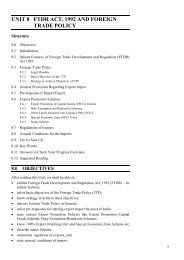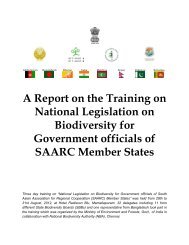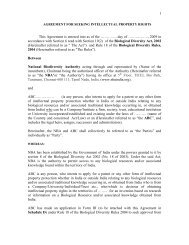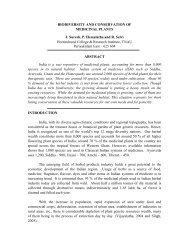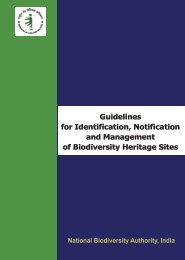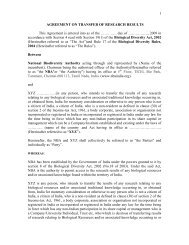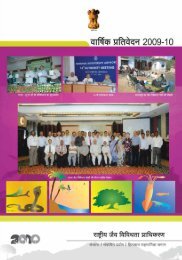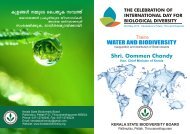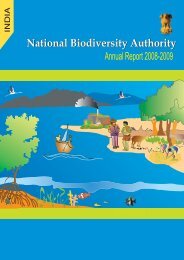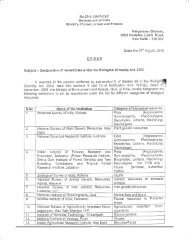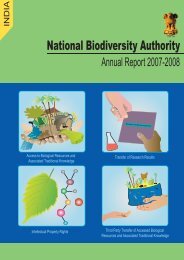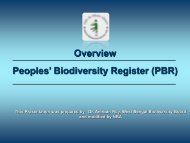Aquatic Plants of India - Part I - National Biodiversity Authority
Aquatic Plants of India - Part I - National Biodiversity Authority
Aquatic Plants of India - Part I - National Biodiversity Authority
You also want an ePaper? Increase the reach of your titles
YUMPU automatically turns print PDFs into web optimized ePapers that Google loves.
AUATIC PLANT DIVERSITY – AREVIEW<strong>Aquatic</strong> <strong>Plants</strong> <strong>of</strong> <strong>India</strong> – <strong>Part</strong> IR. Prakashkumar Ph D, FLSMalabar Botanical GardenA SPECIAL CONTRIBUTION TO NATIONAL BIODIVERSITY AUTHORITY, GOVERNMENT OF INDIAON THE OCCASION OF INTERNATIONAL DAY FOR BIOLOGICAL DIVERSITY - 2013
• Man depends on wetlands• Human civilization around wetlandssystems• Prehistoric & historic temples situated nearwetlands form remnants <strong>of</strong> suchcivilization• Man depends for drinking water,agriculture, fishing water transport,tourism , water sports etc.• Productive Ecosystem– Cradles <strong>of</strong> Biological Diversity
Kerala – 3,28,402 hectares wetlands- 3 designated Ramsar sitesAshtamudibackwaterSasthamkottahlakeVembanadkayalKottuli in Kozhikode<strong>National</strong> WetlandConservation ProgrammeKadalundi in Kozhikode &Malappuram District.
<strong>Plants</strong> <strong>of</strong> wetlands have playedfascinating roles in life• Rhizomes <strong>of</strong> Nelumbo macifera• Fruits <strong>of</strong> Nymphaea nouchali• Bacopa monnieri• Centella asiatica• Eclipta albafoodmedicine• Lagenandra toxicaria - water purifier• Nelumbo nucifera - worship• Typha angustata - thatching• Pandanus fascicularis• Cyperus pangoreimats & baskets
<strong>Aquatic</strong> Ecosystem• Fast diminishing ecosystem‣ Filling‣ Industrial discharge‣ Heavy slitting‣ Exotic weeds• Rich specialized aquatic biodiversity in fastdisappearing
<strong>Aquatic</strong> Vegetation – Based on habitats1) Free - floating hydrophytes‣ Live on the surface <strong>of</strong> water, in contact withair, stagnant waterEichhornia crassipesHygroryza aristataLemna perpusillaPistia stratiotesSpirodela polyrhizaWolffia globosa
<strong>Aquatic</strong> Vegetation – Based on habitats2) Suspended hydrophytes‣ plants anchored and submerged in young stage butlater get detached from their roots and lie below thesurface <strong>of</strong> the water, can not survive in fast flowingwater, restricted to stagnant ponds, tanks.Ceratophyllum demersumEriocaulon setaceumHydrilla verticillataUtricularia aurea
<strong>Aquatic</strong> Vegetation – Based on habitats3) Submerged - anchored hydrophytes‣ <strong>Plants</strong> well below the surface <strong>of</strong> water usuallyanchored. Found both in stagnant andrunning water.Aponogeton appendiculatusBlyxa auberiiCabomba carolinianaOttelia alismoidesVallisnaria natans
<strong>Aquatic</strong> Vegetation – Based on habitats4) Anchored hydrophytes with floating leaves‣ <strong>Plants</strong> usually met within shallow stagnantwaters. Tide over un favourable periods byperennial organs like rhizome, tubers, stolensetc. Characterized by dimorphic leaves –juvenile submerged and mature floating.Aponogeton natansNelumbo nuciferaPotomogeton nodosusSagittaria guayanensis
<strong>Aquatic</strong> Vegetation – Based on habitats5) Anchored hydrophytes with floating shoots‣ plants attached to substratum, branches trail orcreep along water surface, <strong>of</strong>ten rooting atnodes, stagnant watersGeissaspis cristataIpomoea aquaticaLudwigia adscendensL. sedoidesNeptunia prostataTrapa maximowiczii
<strong>Aquatic</strong> Vegetation – Based on habitats6)Emergent - Anchored hydrophytes‣ <strong>Plants</strong> anchored to substratum under water,but produce aerial shoots projecting wellabove water. Inhabit shallow stagnant water.Acorus calamusAeschynomene asperaBacopa monnieriEleocharis spiralisHydrocera trifloraLimnocharis flavaLimnophila aromaticaL. heterophyllaMonochoria vaginalis
Pandanus grove at MBG
Wetland at MBG
Preparation <strong>of</strong> data sheet -On distribution, flowering time ,local uses.• Field Exploration trips.• Information on local names, uses, digital images.• Water samples - P H value recorded.• Plant specimens – Processed into herbarium species.• Live seedlings <strong>of</strong> non weedy/RET – Collected and introducedin garden.• Delicate aquatic plants – Primarily introduced in specialgermination pots for adjusting P H - shifted to conservatory.• Plant specimens identified under stero dissection Microscope.
Collection Trips
Lagenandra nairi‣ Endemic to South <strong>India</strong>
Bruguiera gymnorhiza
Monochoria vaginalis Presl.‣ For burning sensation <strong>of</strong> body‣ Gastropathy, asthma, scurvy & haemorrhage
MONOCHORIA VAGINALIS
Murdania loriformis‣ Wetland and moist places‣ asthma
Trapa natans var. bispinosa‣ Photosynthetic root‣ Haemorrhages, diarrhoea
Neptunia prostrata‣ Shoots are edible‣ Earache and syphilis
NEPTUNIA -- SPONGY TISSUES
Ottelia alismoides‣ <strong>Aquatic</strong> herb‣ Eaten in South-East Asia
Hygrophylla diformis‣ Dimporphic leaves‣ Aquarium plant
Hydrocharis dubia‣ Himalayan regions
Lagenandra toxicaria‣ Endemic to Western Ghats‣ Renal troubles and cardiac ailments
Pistia stratiotes L.‣ Antiseptic, anti dysenteric and cure for asthma‣ Fed to ducks and pigs in Bengal
‣ Shoots are edibleIpomoea aquatica
Utricularia aurea‣ Carnivorous plant
Rotala malampuzhensis‣ Only in Kerala rice fields
Rotala malabarica‣ Endemic to South-West <strong>India</strong>
Nuphar lutea‣ European aquatic plant‣ Recently distributed in <strong>India</strong> as a garden plant
NUPHAR LUTEA
Pimpinella heyneana‣ A rare plant restricted to <strong>India</strong>, Myanmar and Srilanka‣ Wet forest ground
PIMPINELLA
Myriophyllum indicum‣ Endemic to South East Asia and Srilanka‣ In ponds and low land marshes
Lemna minor‣ Foul waters‣ Cleans the organic impurities
Equisetum ramosisimum‣ <strong>Aquatic</strong> fern‣ Rare in Kerala
EQUISETUM CONE
Hydrocera triflora‣ Annual and perennial herb found in shallow water
Wolffia globosa‣ Smallest angiosperm‣ Flowers are microscopic
Limnopoa meeboldii‣ It grows bottom rooted and floating in coastal lagoons‣ Endemic to coastal south-west <strong>India</strong>
Eriocaulon heterolepis‣ Endemic to Western Peninsular <strong>India</strong>
Euryale ferox‣ Annual or short lived perennial‣ The seeds fruits and rhizomes are eaten locally by humans



